Search
To search for an exact match, type the word or phrase you want in quotation marks.
A*DESK has been offering since 2002 contents about criticism and contemporary art. A*DESK has become consolidated thanks to all those who have believed in the project, all those who have followed us, debating, participating and collaborating. Many people have collaborated with A*DESK, and continue to do so. Their efforts, knowledge and belief in the project are what make it grow internationally. At A*DESK we have also generated work for over one hundred professionals in culture, from small collaborations with reviews and classes, to more prolonged and intense collaborations.
At A*DESK we believe in the need for free and universal access to culture and knowledge. We want to carry on being independent, remaining open to more ideas and opinions. If you believe in A*DESK, we need your backing to be able to continue. You can now participate in the project by supporting it. You can choose how much you want to contribute to the project.
You can decide how much you want to bring to the project.
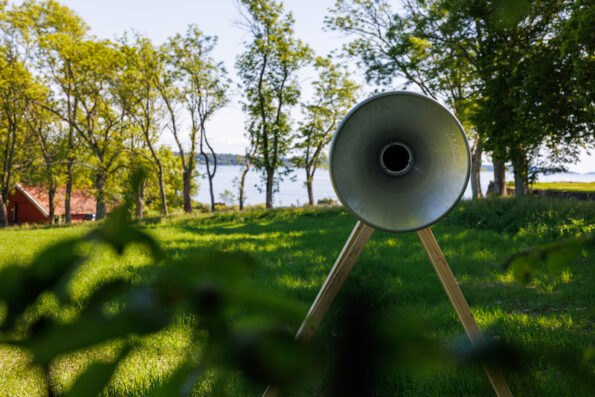
There is something subversive about listening (even if just for the gossip) versus a visual culture that consumes and saturates everything. A society colonized by the eye, overflowing with fleeting stimuli, disconnecting us from direct experience. Where images become tools of misinformation, propaganda, dehumanization, or erasure—think of the documentation of genocide, structural violence, or displacement—sound persists: raw, immediate, inescapable.
Perhaps that is why the recently inaugurated MOMENTUM 13 deactivates the supremacy of the gaze to create space for the invisible: for the sound that erupts and the one that remains as resistance and memory. The audible is not just vibration; it is a living archive of nature, a silent witness that defies erasure. Sound knows no race, language, or border. Hearing is a universal sense, a common territory through which emotion travels without intermediaries. Sound takes us across time and space as a single echo returns us to childhood, or a melody transports us elsewhere.
Even before arriving in Moss—the Norwegian city that hosts the biennial—something pulses in the air. Curated by Morten Søndergaard, MOMENTUM 13 opens a space for resonance: not as a visual translation of the sonic, but as vibration incarnate, moving through the body. Because that’s what sound does: it enters you. As Pauline Oliveros once said, “The body is the first instrument. Listening begins within.”
And then comes the title: Between/Worlds: Resonant Ecologies. RESONANCE, as the phenomenon by which one body vibrates in response to another. Also means an acoustic or affective answer to what is no longer there, or never seen. ECOLOGY, not only of natural systems, but also of relations. Ecology considers interdependencies, fragilities, liminal states. Thus, this year, the biennial unfolds across five interconnected locations as if it were a sustained note (♯) —a single pitch extended through. Each space acts as a listening station: the city of Moss embodies the urban; the forest, the natural; the island of Jeløy, the geological and mineral; and Galleri F 15, the institutional.
Sound disarms because it eludes possession. It is always escape, shadow, body, and atmosphere. It can’t be domesticated or framed. And even though it resists commodification, sound art increasingly permeates the contemporary art sphere. MOMENTUM 13 does not offer spectacle, but something more radical: an ecosystem of works that resonate with each other—and with us—beyond visual logic. It risks the uncomfortable silence, the residual murmur, the spectral frequency of what is usually erased. It proposes a form of attunement, a way of being with water, wind, moss. With reverberations. Of course there are white cubes, but above all, artists who explore sound as not only a sensory, but also an ethical, aesthetic, political, and poetic experience.
One of the most unsettling works is FOREST (for a thousand years…) by Janet Cardiff and George Bures Miller. The Canadian duo installed 22 speakers among the trees, intertwining recordings of war—explosions, screams, helicopters—with the acoustic landscape of the forest: branches creaking, wind, birdsong. The piece generates a sensory experience as well as a sense of suspended time, as it was created in 2012 but tragically relevant today. It confronts the viewer with a brutal coexistence: human violence and the organic persistence of the forest.
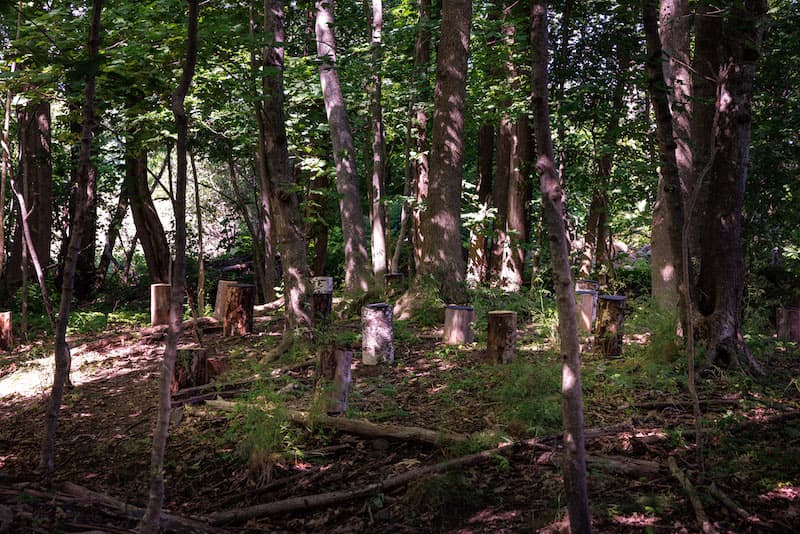
Janet Cardiff & George Bures Miller. Forest (for a thousand years…), 2012
The biennial also unfolds a vast sonic lexicon. One of my favourite conceptual pillars is acoustic justice, a term developed by Brandon LaBelle[1]LaBelle, Brandon. On Acoustic Justice. The Listening Biennial, https://listeningbiennial.net/essays/on-acoustic-justice. that forces us to confront: who claims the right to make noise? Who gets to be heard? In Vis.[un]necessary force_4 (2019), Luz María Sánchez installed a circle of speakers and a touch screen: by tapping it, visitors activate recordings of Las Rastreadoras de El Fuerte, women searching for their disappeared loved ones in northern Mexico. There is no institutional voice here. Only earth, wind, and the tenacious insistence of sound as an archive of violence that refuses to be silenced. Here, acoustic justice is not proclaimed; it is embodied, transmitted, and heard through the body.
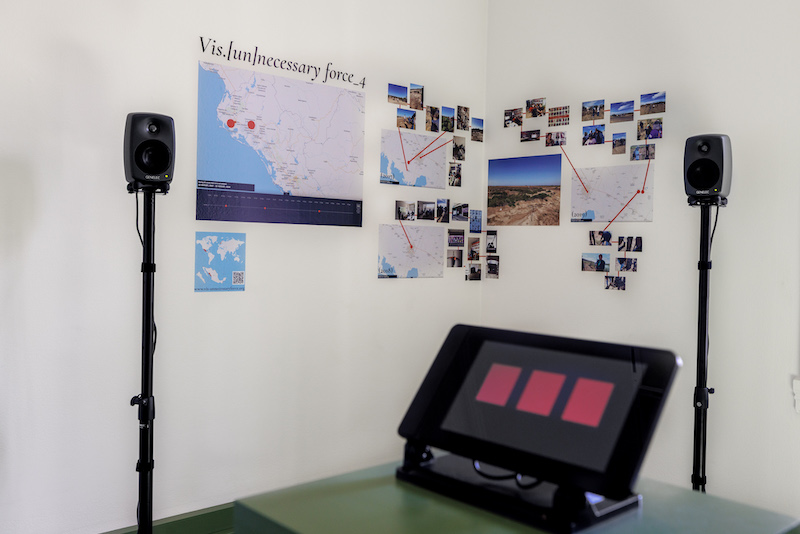
Luz María Sánchez. Vis.[un]necessary force_4, 2019
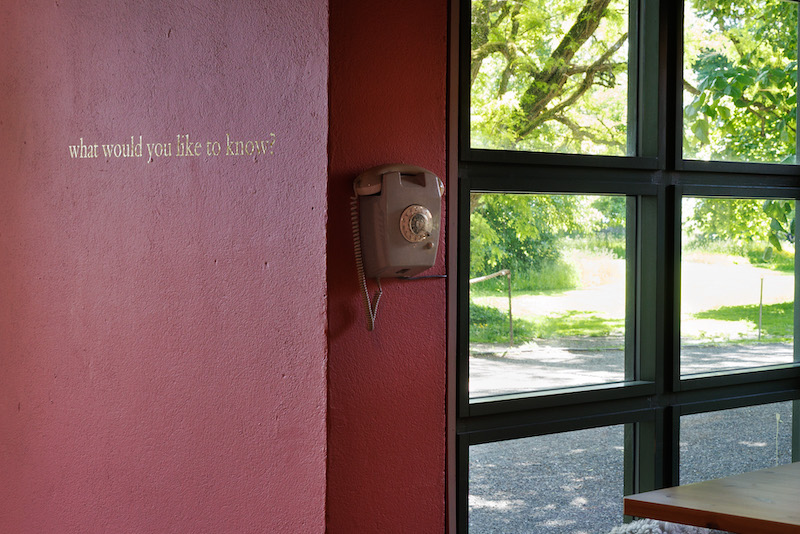
Douglas Gordon. Instruction (what would you like to know), 1992
At the other end of the spectrum, Misterios (2017) by Christian Boltanski features three giant trumpets on the Patagonian coast that, activated by the wind, emit a song reminiscent of whales. The visual register presented at the biennial—a 12-hour projection—documents the slow unfolding of this natural and constructed vibration. What we hear is not just wind, but the deep time of waiting.
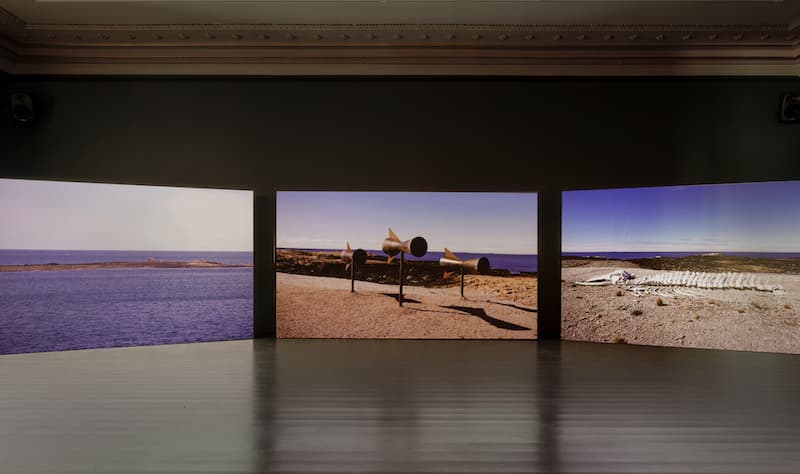
Christian Boltanski. Misterios, 2017
Also central is the concept of ultralocality[3]Søndergaard, Morten, and Ida Uvaas, editors. MOMENTUM 13 Reader: Between/Worlds – Resonant Ecologies. MOMENTUM 13 & Galleri F 15, 2025. —a term that doesn’t allude to folklore or quaintness, but rather to what can only happen at the intersection of matter, wind, and memory. Jana Winderen extracts frequencies from the fjord, capturing the invisible acoustic interactions of marine ecosystems and inviting an ultralocal listening that connects audiences to ecological change.
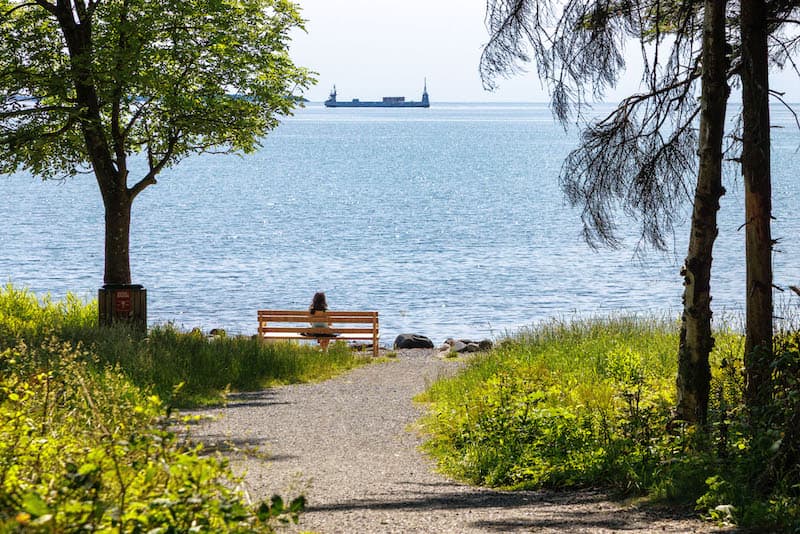
Jana Winderen. here: this place, a listening exercise, 2025
Ultimately, a thread weaves through the biennial: sound as interstitial space, as a threshold between worlds—marine, geological, animal, and human. It’s not about representing the world, but resonating with it. FOAM – Sonic Allegories (2025), by Leena Lee and Robertina Šebjanič, turns sea foam into a metaphor for the entanglement of organic and industrial matter. Through blown glass and field recordings, the piece proposes an empathetic listening to what is fragile, fluid, liminal.
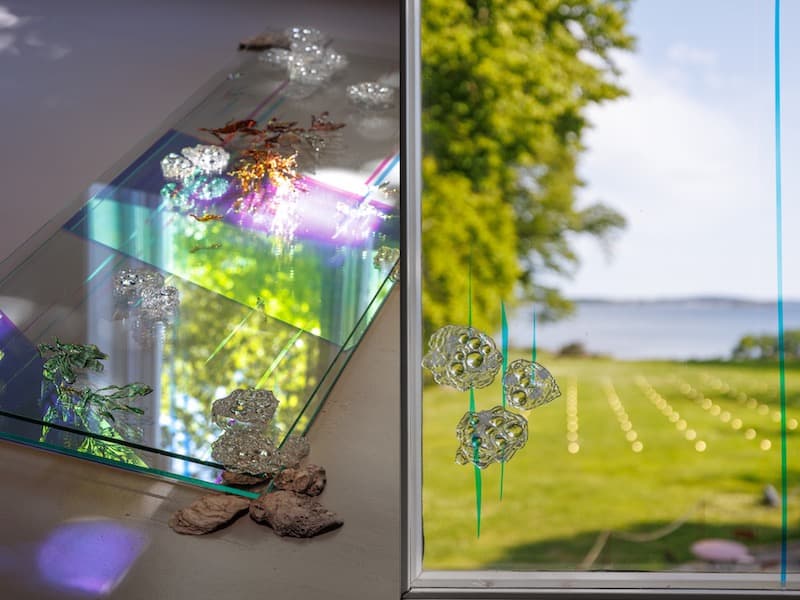
Leena Lee & Robertina Šebjanič. FOAM – Sonic Allegories, 2025
From a geopolitical perspective, the biennial presents 33 works by 42 participants (some in duos or trios): 6 Norwegians, 9 from other Nordic countries, followed by 5 Canadians and 4 from the UK. A Latin American diaspora is also present, with one Colombian and three Mexican artists. Germany, Japan—countries with a rich history in sound art—and France each have two artists; Latvia and the US, one. What if this not-quite-ultralocal resonance extended southward? Artists like Cabo San Roque—who forge instruments from society’s discard pile, their studio a laboratory-archive-orchestra of the unwanted—or Fito Conesa, whose choral-queer frequencies destabilize the European sonic archive’s extractive logic, could unfold new resonances in this biennial.
In the end, MOMENTUM 13 carries a certain je-ne-sais-quoi of ritual, trance, and extracranial connection. It offers a latent critique of the colonizing gaze—that impulse to name before listening. Sound emerges here as a space for resistance, for reconnecting with what is essential. It brings us closer to nature in its most primal state, to the planet’s heartbeat; it lets us feel the presence of wind in the trees, the murmur of water, the echo of what once was and could be again. It’s no coincidence that many ancestral cultures consider sound the very origin of creation, a primordial language that precedes words and rational thought.
Against the spectacular logic of biennials that colonize territory to institutionalize trends, MOMENTUM 13 proposes a politics of attention rooted in relation, in situatedness, in instability. And it operates at a different scale: the sonic, the ecological. Because perhaps it’s no longer about understanding, but about resonating. About letting something pass through us, like that whisper in Calling the Glacier (2007) by Kalle Aldis Laar, where a phone line connects you in real time to the sound of a melting glacier. The planet responds, but not with words.
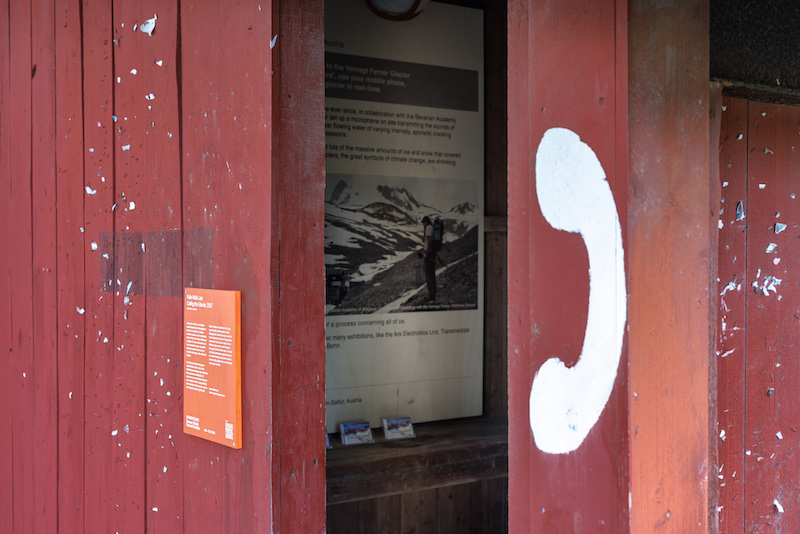
Kalle Aldis Laar. Calling the Glacier, 2007
(Featured image: Stephanie Loveless. Spisslønn / Norway Maple, 2025)
Momentum 13, until October, 12 in Moss, Noruega. + info complete list of artista here.
| ↑1 | LaBelle, Brandon. On Acoustic Justice. The Listening Biennial, https://listeningbiennial.net/essays/on-acoustic-justice. |
|---|---|
| ↑2, ↑3 | Søndergaard, Morten, and Ida Uvaas, editors. MOMENTUM 13 Reader: Between/Worlds – Resonant Ecologies. MOMENTUM 13 & Galleri F 15, 2025 |
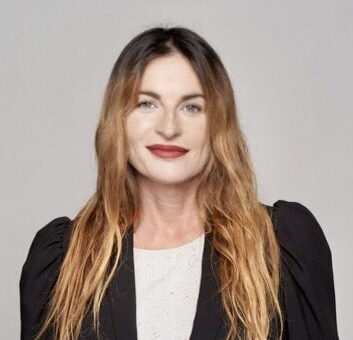
María Muñoz-Martínez is a cultural worker and educator trained in Art History and Telecommunications Engineering, this hybridity is part of her nature. She has taught “Art History of the first half of the 20th century” at ESDI and currently teaches the subject “Art in the global context” in the Master of Cultural Management IL3 at the University of Barcelona. In addition, while living between Berlin and Barcelona, she is a regular contributor to different media, writing about art and culture and emphasising the confluence between art, society/politics and technology. She is passionate about the moving image, electronically generated music and digital media.
Portrait: Sebastian Busse
"A desk is a dangerous place from which to watch the world" (John Le Carré)